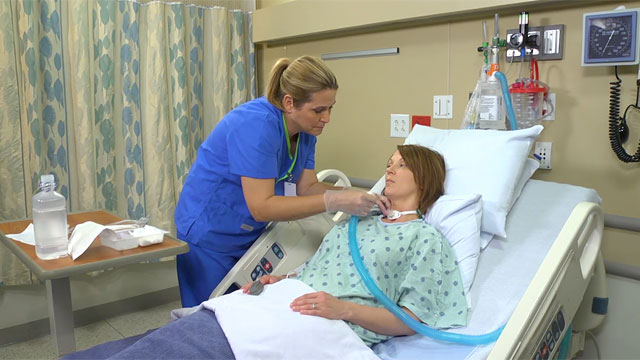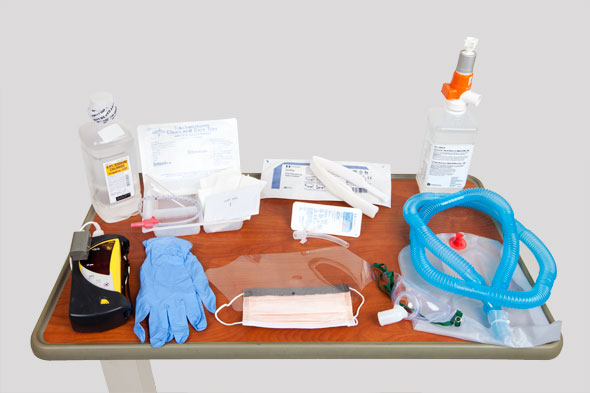Respiratory Care and Suctioning
Select a Skill:
- » Ensuring Oxygen Safety
- » Setting Oxygen Flow Rates
- » Applying a Nasal Cannula or Face Mask
- » Maintaining an Airway
- » Providing Tracheostomy Care
- » Performing Oropharyngeal Suctioning
- » Performing Nasotracheal and Nasopharyngeal Suctioning
Take the Review Test:

Safety
- When an assistant is helping replace neck ties, instruct him or her not to release the tracheostomy tube until the new ties are firmly in place. If you are working without an assistant, do not cut the old ties until the new ties are in place and have been securely tied.
- If accidental extubation occurs, call for assistance. Manually ventilate the patient with a resuscitation bag if needed. Keep a tracheostomy obturator at the bedside to facilitate reinsertion of a dislodged outer cannula. For emergency replacement, keep on hand an additional tracheostomy tube of the same size and shape as the one in use.
- Do not use scissors to cut 4 x 4–inch gauze pads to make a tracheostomy dressing. Cutting causes the pads to shed fibers that the patient could inhale. Instead, use a pad specifically designed for use as a tracheostomy dressing.
Equipment
(Roll cursor over items to see labels)

Pulse oximeter
Oxygen mask and tubing
Tracheostomy care kit (contents may vary)
- Sterile 4x4 inch gauze pads
- Sterile cotton-tipped applicators
- Cleansing brush
- Suction catheter
- Sterile basin
- Sterile gloves
- Sterile drape
Sterile tracheostomy dressing (precut)
Normal saline
New inner cannula (if appropriate)
Tracheostomy tube holder
Tracheostomy humidifier (optional)
Clean gloves
Face shield (optional)
Delegation
The skill of performing tracheostomy care is not routinely delegated to NAP. In some settings, care may be delegated to NAP for patients who have well-established tracheostomy tubes. In all cases, the nurse is responsible for assessing the patient and for providing proper artificial airway care. Be sure to instruct NAP to report the following immediately:
- Any changes in the patient’s respiratory status or level of consciousness
- Increased confusion, restlessness, irritability, or change in level of comfort
- Dislodgment or excessive movement of the tracheostomy tube
- Abnormal color of the tracheal stoma and drainage
Preparation
- Observe for excessive peristomal secretions, excessive intratracheal secretions, soiled or damp tracheostomy ties, soiled or damp tracheostomy dressings, diminished airflow through the tracheostomy tube, and signs of airway obstruction requiring suctioning.
- Assess the patient’s hydration status, humidity delivered to the airway, the status of any existing infection, nutritional status, the patient’s ability to cough, vital signs, oxygen saturation, lung sounds, the patient’s ability to clear the airway, and the patient’s understanding of his tracheostomy care and his ability to perform care.
- Check when tracheostomy care was last performed.
- Have another nurse or NAP assist in tracheostomy care.
- Explain the procedure to the patient, and explain what he or she needs to do.
- Help the patient into a position that is comfortable for both you and him or her. This is usually the supine or semi-Fowler’s position with a towel placed across the patient’s chest.
Follow-up
- Compare the patient assessments performed before and after tracheostomy care.
- Assess the fit of the new tracheostomy ties. Ask the patient if the tube feels comfortable.
- Inspect both inner and outer cannulas for secretions.
- Assess the stoma for inflammation, edema, and discolored secretions.
Documentation
- Record respiratory assessments before and after care. Record the type and size of tracheostomy tube and the frequency and extent of care.
- Record the type, color, and amount of secretions, the patient’s tolerance and understanding of the procedure, and any special care taken for unexpected outcomes.
- Report accidental decannulation or respiratory distress to the health care provider.
Review Questions
1. How can the nurse best minimize a patient’s risk for infection during tracheostomy care?
 Adhere to sterile technique when appropriate.
Adhere to sterile technique when appropriate. Frequently assess for signs of local or systemic infection.
Frequently assess for signs of local or systemic infection. Monitor for indications that tracheostomy care is needed.
Monitor for indications that tracheostomy care is needed. Instruct nursing assistive personnel (NAP) to report any changes in color or odor of tracheal drainage.
Instruct nursing assistive personnel (NAP) to report any changes in color or odor of tracheal drainage.
2. Which nursing action shows the most effective planning for emergency care of a patient with a tracheostomy?
 Having a spare oxygen mask at the patient’s bedside
Having a spare oxygen mask at the patient’s bedside Keeping an obturator and a tracheostomy tube at the patient’s bedside
Keeping an obturator and a tracheostomy tube at the patient’s bedside Reviewing the agency’s policy regarding tracheostomy care
Reviewing the agency’s policy regarding tracheostomy care Instructing the family to call immediately if the patient has difficulty breathing
Instructing the family to call immediately if the patient has difficulty breathing
3. Which intervention reduces the risk for skin breakdown in a patient with a new tracheostomy?
 Cleaning the stoma with hydrogen peroxide and drying thoroughly
Cleaning the stoma with hydrogen peroxide and drying thoroughly  Cleaning and assessing the skin around the stoma
Cleaning and assessing the skin around the stoma Assessing temperature and reporting skin breakdown immediately
Assessing temperature and reporting skin breakdown immediately Allowing the patient to re-oxygenate after each tracheal suctioning
Allowing the patient to re-oxygenate after each tracheal suctioning
4. Which action may be delegated to nursing assistive personnel (NAP) regarding the care of a patient with a tracheostomy?
 Performing tracheostomy care for a patient whose tracheostomy was placed 1 week ago
Performing tracheostomy care for a patient whose tracheostomy was placed 1 week ago Removing the outer cannula and placing the obturator
Removing the outer cannula and placing the obturator  Holding the tracheostomy tube while the nurse changes the neck ties
Holding the tracheostomy tube while the nurse changes the neck ties  Monitoring oxygen saturation levels and placing oxygen if needed
Monitoring oxygen saturation levels and placing oxygen if needed
5. Which technique would the nurse use to change a patient’s tracheostomy ties?
 Use a slipknot.
Use a slipknot. Ensure that two fingers fit snugly under the tie.
Ensure that two fingers fit snugly under the tie. Knot the ends of the tie in the eyelets on the faceplate.
Knot the ends of the tie in the eyelets on the faceplate.  Ask the patient to hold his or her breath while the ties are changed.
Ask the patient to hold his or her breath while the ties are changed.
You have completed the Review Questions for this skill. To take the Review again select the Start Over button. To proceed to another skill select from the dropdown menu. Select the Home or Back button to proceed to the next section.

